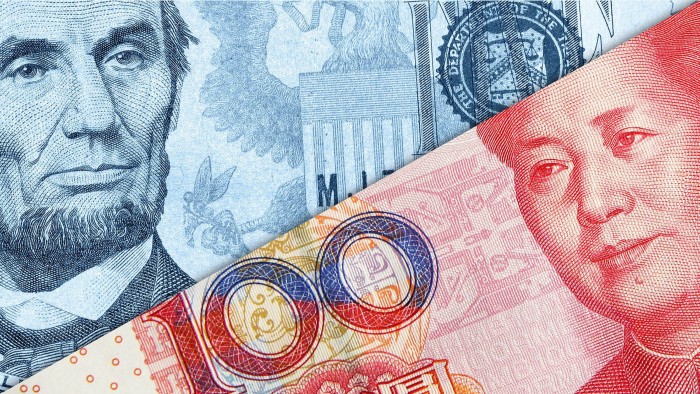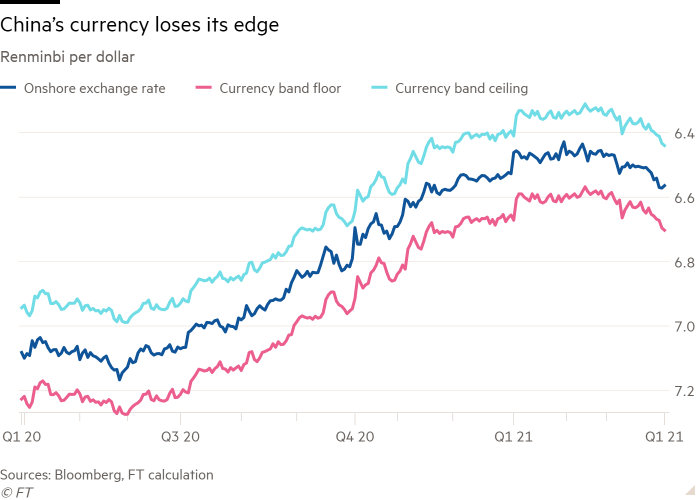China’s currency set for worst month since US trade war

Roula Khalaf, Editor of the FT, selects her favourite stories in this weekly newsletter.
China’s currency is set for its worst month against the dollar in more than a year and a half, as investors fret that a clampdown on borrowing could slow the country’s swift economic recovery from Covid-19.
The tightly regulated onshore-traded renminbi fell 1.4 per cent against the greenback in March to about Rmb6.57, marking its worst one-month drop since August 2019, when Washington labelled Beijing a currency manipulator. The recent drop also erased the Chinese currency’s gains against the dollar since the new year.
The fall represented a partial reversal for China’s currency after a banner 2020, when demand for the renminbi drove gains of 6.7 per cent. Offshore investors, eager to capitalise on the country’s rapid economic rebound from the coronavirus pandemic, poured more than Rmb1tn into China’s bond and stock markets.
It also reflected the fact that Beijing faces a dilemma regarding whether to withdraw stimulus now that the world’s second-biggest economy has recaptured its pre-pandemic growth rate, just as the recovery elsewhere in the world begins to pick up steam.
Economists said that China’s vague recently announced GDP growth target of “over 6 per cent” for 2021 was weighing on the currency. That is because it may signal authorities could be willing to clamp down on financial risk so forcefully that growth for the year could come in well below the 8.5 per cent forecast by economists polled by Bloomberg.
“China’s economy is now well above trend and, with policy stimulus being withdrawn, is on course for a cyclical slowdown that isn’t reflected in consensus expectations,” said Julian Evans-Pritchard, senior China economist at Capital Economics. “At the same time, the outlook for the rest of the world has brightened”.
That shift has been felt in global bond markets. In recent weeks, the difference in yields between Chinese government bonds and their US counterparts has narrowed sharply. Analysts said the gap could close further, which would make Chinese bonds less attractive for international investors and dampen a main driver of inflows into the country last year.
“By the end of 2022, we think the China yield premium could hit a decade low . . . Portfolio inflows to China, which picked up sharply last year, will slow or even reverse,” Evans-Pritchard said.
One area where inflows are likely to grow is via passive investors, or those that track indices. On Tuesday, FTSE Russell confirmed it would begin adding Chinese debt to its benchmark World Government Bond index in October with a 5.25 per cent weighting.
Analysts at Citi estimated the inclusion would drive about $105bn of passive inflows into Chinese government bonds over a three-year period.

Chinese equities are also lagging their global peers — squashing another driver of global demand for the renminbi. China’s CSI 300 index of Shanghai- and Shenzhen-listed stocks has dropped more than 15 per cent from its recent peak in mid-February.
Analysts said that while the People’s Bank of China would welcome some weakness in the currency, which could help boost exports, few expected runaway depreciation against the dollar.
The central bank, which sets a daily midpoint for the renminbi’s dollar trading band, said last week that it planned to make the currency’s exchange rate more flexible — a signal that analysts said often correlated with depreciation.
“The market clearly picks up on these phrases,” said Mansoor Mohi-uddin, chief economist at Bank of Singapore. “If it feels authorities don’t want the [exchange] rate to trend higher, we see a pullback.”
Comments